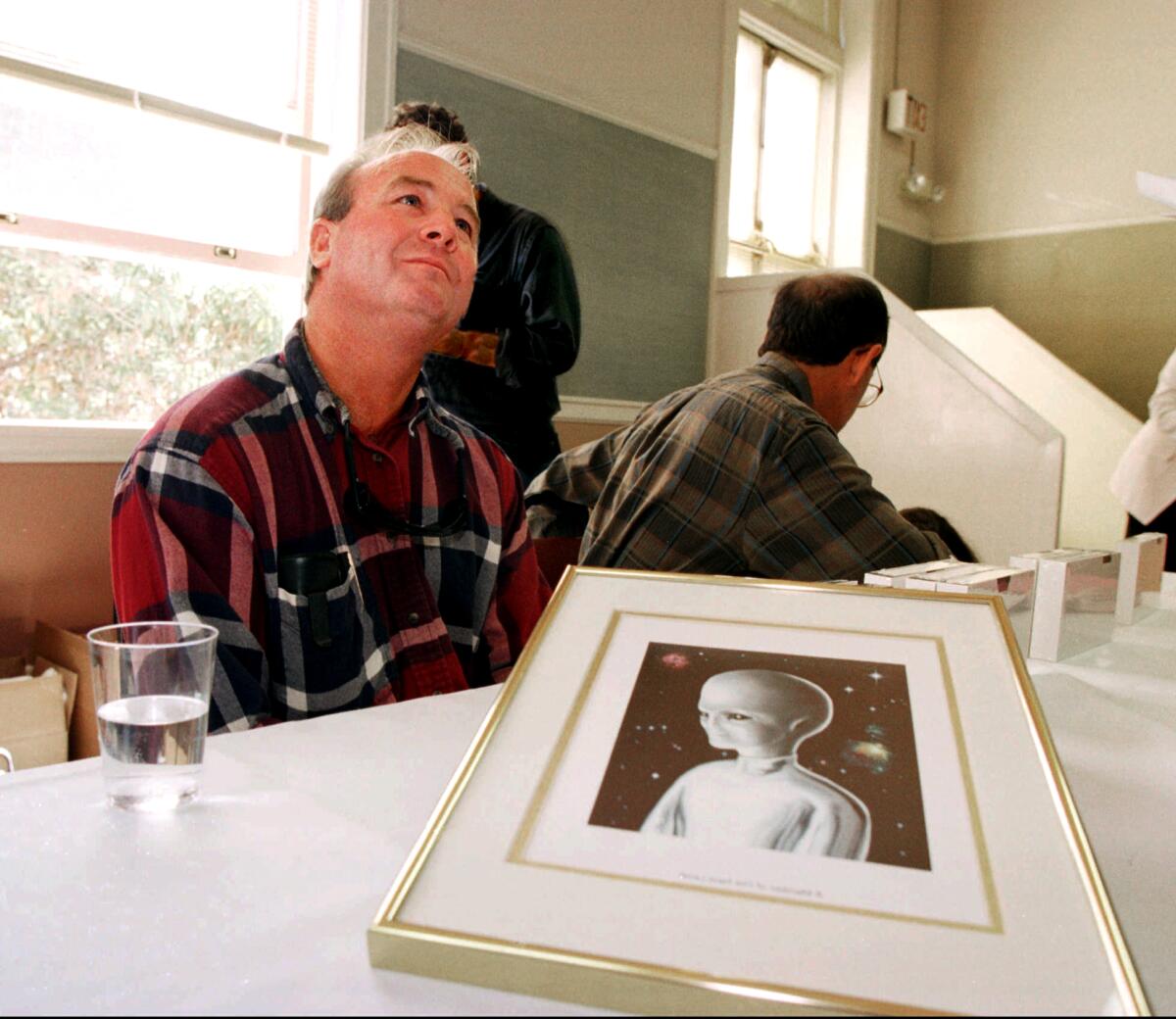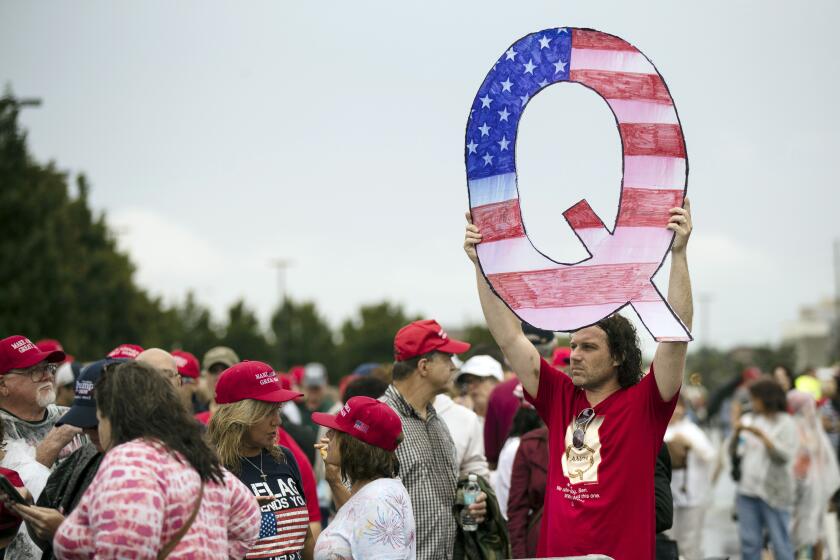Op-Ed: Why QAnon’s similarity to other cults makes it a significant national security threat

- Share via
It would be a mistake to believe that the election of Joseph R. Biden as president will silence the QAnon movement. Adherents of the conspiracy theory made former President Trump into a quasi-religious figure, and when he lost the November election it forced them to confront a reality that challenged the essence of their belief system. So they did what cults often do — and bent their narrative.
Instead of admitting defeat, some QAnon followers are promoting a new convoluted conspiracy theory with the outcome they desire: Trump will once again be sworn in as president of the United States on March 4.
The most radical QAnon believers exhibit traits that have manifested among dangerous cults and doomsday groups — a willingness to dismiss their own individuality for a perceived greater good. These disciples often shun their families and friends in favor of QAnon fantasies. They identify with a calling to participate in a movement and share a belief that they are improving society, or themselves, in a new way. Members of the QAnon movement seem to truly believe they are fighting a secret cabal of elites who are engaged in the exploitation of children. Believers often wear clothes adorned with the letter “Q” and use slogans such as “Where we go one, we go all” as mantras to illustrate their commitment to a belief system.
Despite repeated predictions associated with the QAnon movement proving to be false — such as the arrival of an apocalyptic storm that would destroy the “deep state” during Trump’s presidency — the conspiracy theory continues to captivate followers by morphing its messaging to remain relevant. For more than a decade, I had observed that phenomenon as a federal government official charged with sanctioning groups and individuals as “terrorists.” By examining classified and unclassified research, I came to know the vicissitudes of ethno-nationalist separatists, religiously motivated extremists, left- and right-wing radicals and cults.
The followers of Q — an anonymous figure thought to be an individual or a group of people — more than fit the pattern. The QAnon movement has successfully blended elements of religious and cult-like practices to harden QAnon individual belief systems of its most ardent supporters. Because of this, I remain highly concerned that the QAnon movement constitutes a significant national security threat.
All presidential candidates want a big tent. But is it necessary to invite in people who believe the ‘deep state’ is promoting pedophilia?
In 2017, Q began anonymously posting conspiracy theories. The first one purported to explain that Hillary Clinton was about to be arrested and her passport had been flagged in case she tried to flee the U.S. It was relatively straightforward, and wrong. Future posts, known as Q-drops, were inchoate. Q’s followers, some of whom attracted large social media followings, would feverishly try to decrypt Q’s riddles. Over time, the posts and decryptions began to take on more religious and violent overtones. And, ominously, they began to attract more followers.

Most cults have easily identifiable leadership figures who push members to the edifice of a belief system, but Q remains ethereal even while delivering messages to the faithful for four years. Trump’s outsized presence brought him a messianic-like following within the movement. Together, Q and Trump are an ample substitute for a clear cult-like figure. According to the most zealous of believers, if Trump or Q say something, it must be true — or eventually will be.
And if someone cannot see the so-called truth, they aren’t looking hard enough. A refrain among QAnon adherents I track online is “dig deeper.” The phrase is often uttered by seemingly hardcore believers and is directed at those who begin to question the conspiracy theory or say they cannot see it.
In 2020, amid a global pandemic and a contentious U.S. presidential race, the QAnon conspiracy theory took on even more sinister overtones. The language of QAnon began to parallel that of previous cult leaders who had encouraged followers to take another step forward toward full indoctrination — a step that could result in self-harm or staging an attack.
For example, after one of the co-founders of the Heaven’s Gate cult died, the other began preaching about taking followers to the “Next Level,” a science-fiction version of the afterlife. To explain the unexpected death of his co-founder, he began sermonizing that his followers’ bodies were unimportant vessels that they would shed upon reaching their final destination. He blended aspects of New Age science and evangelical Christianity to persuade them to go on one final trip, which ended with a mass suicide by 39 cult members in 1997.
Like the Heaven’s Gate cult, the QAnon community brandishes religious imagery and repurposes theories to fit new truths. Q’s theory about an impending storm where global elites are vanquished is a recurring end-times scenario in many religions, including Christianity. The predicted storm is still coming, they now say, when Trump retakes power on March 4.
When the Rajneesh Movement emerged in the 1970s, it used spirituality to cultivate a mass following, much like QAnon does. Leader Bhagwan Shree Rajneesh was known for saying variations of “I was asleep, and I am awake, and you can be awake also.” This message is echoed in the QAnon concept of a “Great Awakening,” a single event where people will become enlightened and see the truth. Ultimately, Rajneesh’s followers turned to violence, poisoning salad bars in 1984 as part of a failed plan to depress voter turnout in an Oregon election. It was the first documented bioterrorism attack in the United States.
The Rajneesh movement’s overarching philosophy — to awaken the masses and then steal an election — could have served as a blueprint for the many QAnon members who stormed the Capitol Jan. 6 in an act of politically motivated violence with the objective of gaining power.
Like the cults that came before them, the followers of QAnon see great purpose in what they do — they believe they are saving God’s children. When March 4 comes and goes, and President Biden remains firmly in power, the threat of violence by QAnon conspiracists will persist. They’ll simply shift their narrative, hatch new plots and repurpose old ones — and endure as a potentially deadly menace.
Jason Blazakis is a professor of practice at the Middlebury Institute’s Center on Terrorism, Extremism and Counterterrorism and a senior research fellow at the Soufan Center.
More to Read
A cure for the common opinion
Get thought-provoking perspectives with our weekly newsletter.
You may occasionally receive promotional content from the Los Angeles Times.











